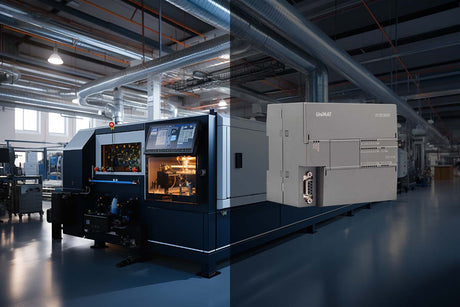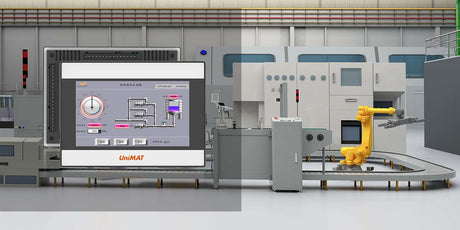The development of industrial automation is inseparable from the efficient control capability of PLC(programmable logic controller).As the core of the automation system,PLC is widely used in multiple industrial scenarios due to its flexibility,stability and programmability.This article analyzes the actual value of PLC in different fields through 10 typical application cases,presents technical details in an easy-to-understand way,and helps readers fully understand its core role.
1.PLC collaborative control in production line automation
In the assembly lines of the automotive,electronics and other industries,PLC coordinates the linkage of robotic arms,conveyor belts and quality inspection equipment through programming.For example,a certain automobile assembly line uses PLC to control multi-station collaborative operations,receive photoelectric sensor signals in real time,synchronize welding,tightening and spraying processes,reduce process waiting time,increase production capacity by 25%,and realize automatic shutdown protection for faults.
2.PLC logic design for precise movements of manipulators
The complex movements of the six-axis manipulator rely on the high-precision control of PLC.Through analytical trajectory algorithms and sensor feedback,PLC drives the servo motor to complete grasping,rotation and positioning.In a typical case,a factory optimized the robot's anti-collision logic through a PLC program,increased the action repetition accuracy to±0.05mm,and successfully applied it to the precision chip packaging scenario.
3.PLC full-process control of packaging machinery
In the field of food packaging,PLC can integrate weighing,filling and sealing functions.A fully automatic packaging machine uses PLC closed-loop control of heat sealing temperature,combined with PID algorithm to dynamically adjust the heating power,so that the packaging speed is stable at 150 packs/minute,and the sealing pass rate is as high as 99.8%,significantly reducing the waste of raw materials.
4.PLC energy-saving solution for inverter linkage
The linkage between PLC and inverter plays an important role in the fan and water pump system.A central air-conditioning project uses PLC to monitor the ambient temperature and humidity in real time,dynamically adjusts the inverter output frequency,reduces the energy consumption of the water pump by 35%,and avoids equipment loss caused by frequent start and stop of the motor.
5.PLC redundant control for safe operation of elevators
The elevator control system requires extremely high safety and real-time performance.PLC processes floor signals,leveling sensors and brake commands through redundant design to ensure that backup power is automatically enabled and the vehicle stops smoothly in the event of a sudden power outage.A commercial complex adopts a dual PLC redundant architecture,shortening the fault response time to 50ms,greatly improving the safety of taking the elevator.

6.PLC-PID algorithm optimization for temperature control
In industrial ovens and injection molding machines,PLC combines thermocouples and analog modules to achieve precise temperature control.A certain injection molding workshop adjusts the heating power through the built-in PID algorithm of PLC to control the mold temperature fluctuation within±0.3℃,improve the product size consistency by 18%,and reduce the scrap rate.
7.PLC fast response of power relay protection
In the power system,the high-speed processing capability of PLC ensures the safety of the power grid.When a line short circuit is detected,PLC can trigger the circuit breaker to trip within 15ms and record the fault waveform data.A substation project uses PLC to implement three-stage overcurrent protection,shortening the power outage recovery time by 40%and reducing economic losses.
8.PLC Visual Monitoring Integrated with SCADA
PLC is combined with SCADA system to realize remote management of equipment.A sewage treatment plant uploads water quality parameters to the SCADA platform in real time through PLC.Operation and maintenance personnel can remotely start and stop pump stations and generate energy consumption reports,reducing labor costs by 50%and increasing fault handling efficiency by 4 times.
9.PLC Logistics Scheduling for Intelligent Warehousing
In the automated warehouse,PLC controls the collaborative operation of stackers and AGV carts.An e-commerce warehouse uses PLC to parse WMS system instructions,optimize shelf access paths,and increase inventory turnover efficiency by 60%,with an error rate of less than 0.01%.
10.PLC Intelligent Strategy for Pump Start and Stop
In the municipal water supply system,PLC automatically switches the pump operation mode according to the water level and pressure signals.A project uses PLC to write an energy-saving scheduling program to realize the rotation of pump groups and priority start and stop during off-peak electricity price periods,saving more than 200,000 yuan in electricity bills annually.
Summary:PLC technology drives industrial intelligent upgrades
From mechanical control to energy management,PLC has become a universal solution for industrial automation through modular design and multi-protocol compatibility.In the future,with the integration of edge computing and AI technology,PLC will further expand its application boundaries in predictive maintenance,data analysis and other fields,providing a solid technical foundation for intelligent manufacturing.Unimat has been focusing on PLC R&D and production for 20 years,seamlessly compatible with Siemens,supporting free prototype testing and 3-year warranty.Welcome to contact Unimat.









